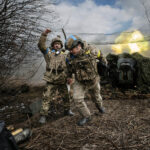Russian ships able to perform underwater operations were present near to where explosions later took place on the Nord Stream pipelines, according to an investigative documentary.
The vessels were reportedly located using intercepted Russian navy communications.
Underwater explosions last September knocked the two Nord Stream pipelines – built to carry gas from Russia to Europe – out of action.
The cause of the blasts is unclear.
Formal investigations are still taking place in countries close to the blast site. So far, they have said only that they believe the explosions were the result of sabotage rather than any kind of accident.
But one possible lead pointing towards Russian involvement has emerged from details of suspicious Russian ship movements in the run-up to the Nord Stream blasts, reported by four Nordic public broadcasters and an accompanying English-language podcast Cold Front.
And Denmark’s Defence Command has confirmed a separate report that a Danish patrol boat called Nymfen took 26 photos of a Russian submarine-rescue ship in the area days before the explosions. The Information website said the SS-750 had sailed from Kaliningrad and was close to Bornholm island on 22 September 2022.
The investigation by Denmark’s DR, Norway’s NRK, Sweden’s SVT, and Finland’s Yle focuses on the movements and actions of ships between June and September last year which they describe as highly unusual.
The ships are believed to include the Russian naval research vessel Sibiryakov, the tugboat SB-123, and a third ship from the Russian naval fleet that the media outlets have not been able to identify by name.
These were so-called “ghost-ships”, which had their transmitters turned off. The broadcasters, however, say they were able to track their movements, using intercepted radio communications the vessels sent to Russian naval bases.

The first vessel departed from a Russian naval base in Kaliningrad before arriving near the pipeline on 7 June.
One radio message places it directly above Nord Stream 2 before moving further north, close to the Nord Stream 1 pipelines, spending hours in the area where the pipeline runs about 80m (260ft) below the surface and where some of the leaks would later occur.
The Sibiryakov arrived on 14 June and went to the same position as the first vessel, close to Nord Stream, and remained there until the next day.
The movements were tracked by a former British naval intelligence officer, who worked on interception of the Russian Baltic Fleet until he retired in 2018. The anonymous officer says he used open-source information and radio communications to carry out his research.
He says the pattern of radio communications in June indicated they were in an “operational phase” at some points.
The tugboat, the SB-123, sailed out to the area on the evening of 21 September. The broadcasters say they intercepted communications that suggest it was operating close to the pipelines and the areas of the explosion from late that evening until around 14:00 on 22 September.
The tugboat is also mentioned in the Information story about the SS-750 submarine-rescue ship, which followed up a German report in March of suspected Russian involvement in the area.
Satellite imagery examined by the broadcasters is said to support the claims about the unusual routes, and other reports in Germany had claimed it was in the area on 21-22 September.
The Sibiryakov is believed to be capable of underwater surveillance and mapping as well as launching a small underwater vehicle. It can be used to support and rescue submarines and has the ability to carry out operations on the seabed, according to experts interviewed by the broadcasters.
The Nordic broadcasters do not say there is conclusive proof of what the vessels were up to or that Russia was behind the blast. But the documentary raises questions about the unusual nature of the activity.
Last month the series revealed that Russian vessels appeared to be mapping out wind farms in the North Sea, including off the UK coast.
Russia has consistently denied any involvement in the blasts.
In the immediate aftermath, some in the West pointed the finger at Russia, while Moscow blamed Western countries, including the UK.
More recently, there were reports that intelligence pointed towards pro-Ukrainian operatives, although not the Ukrainian government itself.

Source : BBC
















